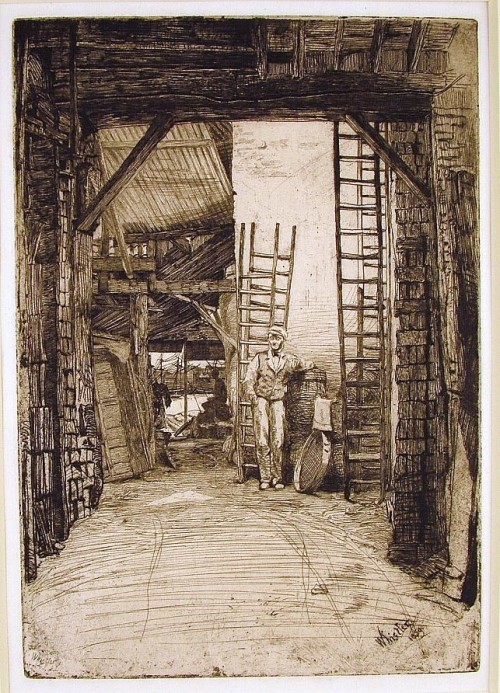The Lime-Burner, state 1
 James McNeill Whistler (1834-1903), The Lime-Burner, 1859, etching and dryoint, printed in brown on laid paper, with wide margins
James McNeill Whistler (1834-1903), The Lime-Burner, 1859, etching and dryoint, printed in brown on laid paper, with wide margins
Kennedy 46, first state (of two), Lochnan 49; 9 7/8 x 6 3/4, the sheet 14 5/8 x 10 5/8 inches. Watermark: Hudelist
provenance:
Edgar Degas, Paris (Lugt 657)
P. & D. Colnaghi & Co., London (their stock no. in pencil in lower margin C.13502)
A fine impression of the rare first state. This impresssion was exhibited widely in the traveling exhibit of etchings and other works from the Degas collection.
The print was exhibited at the Royal Academy in London in 1860 under the title W. Jones, lime-burner, Thames Street. Forming the visual center of an early example of Whistler’s frame-within-a-frame compositions, the figure of Mr. Jones, although small, is nevertheless treated very much like a portrait and the name explicitly given by Whistler in the title for the Royal Academy would confirm this. The lime-burner looks straight out at the viewer while the artist’s complex perspectival devices draw us back into the depth of the image; here a passage opens a small view onto the river and even beyond to the other bank of the Thames.
The Degas provenance of this print is highly intriguing. Katharine Lochnan (Etchings of James Whistler) quotes a letter from Mary Cassatt to Joseph Pennell in which she writes that “long ago M. Degas told me he had once written a very urgent letter to Whistler asking him to join a group of painters who were intending to exhibit together, the same group afterwards nicknamed impressionists, but Whistler never replied to the letter” (Lochnan, p. 223). (For an interesting discussion of the relationship of Whistler and Degas see: Betsy G. Fryberger, Whistler: Themes & Variations, 1978.)